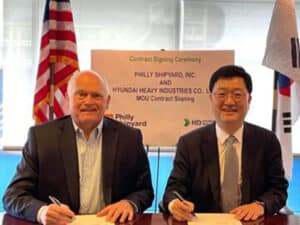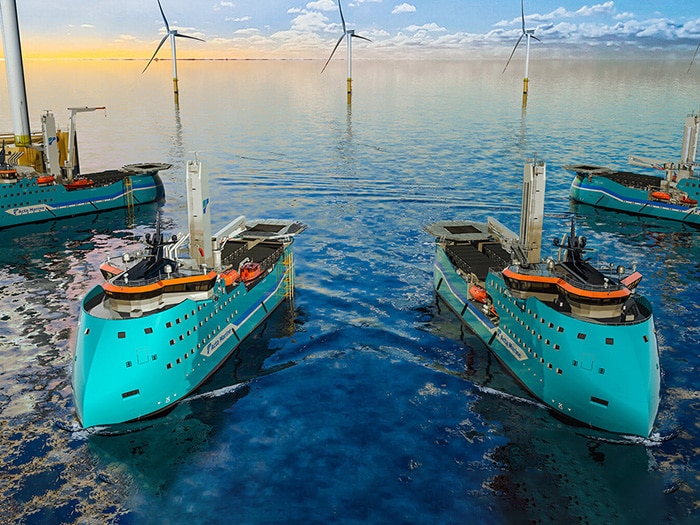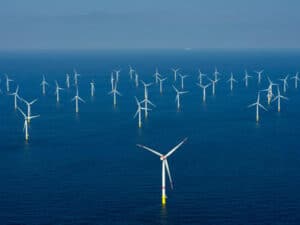
Acta Marine orders two next-gen methanol dual-fuel CSOVs
Written by Nick Blenkey
Methanol dual fuel CSOVs will have a range of GE Power Conversion solutions
Rotterdam-headquartered Acta Marine has signed a contract for the construction of two next-generation offshore wind construction service operating vessels (CSOVs) at Turkey’s Tersan Shipyard. Built to a new SX-216 Twin-X stern design by Ulstein Design & Solutions, the DP2 dual-fuel vessels will be capable of operation on methanol and MDO/HVO.
The contract with the shipbuilder includes options for two further ships.
Ulstein says that its Twin X-Stern has several characteristics, but the easiest way to describe it is as a ship with two sterns and four main propeller units: two at each end. It says the X-Stern at each end results in excellent operability with either end towards the weather, without limitation on vessel speed.
Measuring 89 meters long and 19 meters wide, the vessels will be able to accommodate up to 135 people in 85 cabins. They will be equipped with motion compensated gangway systems supplied by SMST, mounted on the integrated towers with height adjustment and a personnel/cargo lift. In addition to the advanced gangway system, they feature an SMST 3D-motion compensated crane with 6 tons lift capacity and have 500 square meter interior and 500 square meter outdoor cargo areas.
The vessels are designed to provide a short, efficient and safe transfer of personnel and cargo even in harsh weather conditions with wave heights of 3.00 meters
WHY METHANOL?
“The dedicated SX-216 design with a Twin-X stern, an integrated walk-to-work gangway system and 3D crane and its hotel style accommodation represents a next step in responding to the market needs,” says Rob Boer, managing director at Acta Marine. “A first in offshore wind this vessel will be capable of operating on dual fuel methanol and MDO/HVO enabling a strong carbon footprint reduction in the near future, in combination with a battery power system.”
With a strong ESG and sustainability focus Acta Marine sees methanol as one of the most viable alternatives to minimize its carbon footprint.
“Dual fuel methanol driven propulsion trains score high in terms of technology readiness and are eligible for further enhancement to a single fuel methanol upgrade at a later stage,” says Simon Anink, general manager at Acta Marine. “This will allow early application of significant CO2 reduction measures now, while still allowing net-zero operations over the life of the ship”
The CSOVs have a hybrid power solution, with green methanol intended as the main source of energy. The dual-fuel engines are supported by a battery package, integrated into the vessel in such a way as to allow the most fuel-efficient modes of operation, reduced maintenance costs and reduced emissions.
“Acta Marine has a strong wish to offer their clients the largest possible reduction of emissions straight from delivery of the vessels. Therefore, these vessels required a practical and timely available solution to reduce their carbon footprint from the outset of the design”, says Erwin Jager of Ulstein Design & Solutions AS.
“The carbon footprint of marine gas Oil (MGO) makes MGO non-sustainable as the sole choice for the future,” notes Jager. “Currently, the decision on what alternative fuel to focus on can be overwhelming as it is affected by many factors internally and externally. Through a decision support process, developed by Ulstein to guide owners in the myriad of choices to be made, a matrix of alternative fuels has been evaluated towards a set of criteria unique to the shipowner and the business case. Through this process, methanol came out as the winner for this project, with the best overall score. The energy density and storage of methanol is favorable, it is an accessible energy source, and there are dual-fuel engines available in the market that can handle both methanol and diesel.” states Jager.
As soon as methanol had been chosen as an alternative energy source, Ulstein Design & Solutions started to adapt the design, implementing the methanol bunkering, tank and system layouts at a conceptual level.




